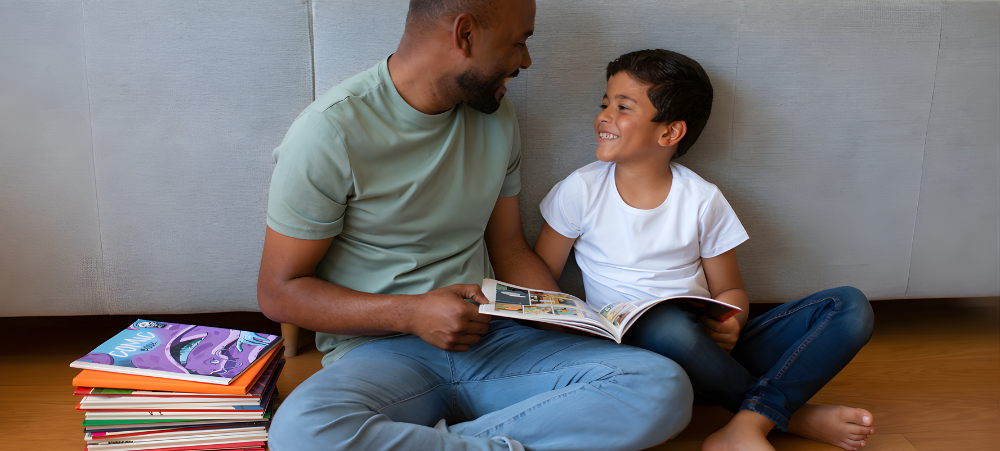Big emotions—anger, sadness, fear, frustration—can feel overwhelming for children. These emotions are a normal part of growing up, but young children often lack the tools to understand and manage them effectively. As a parent, helping your child navigate these feelings is key to fostering emotional resilience and building healthy coping mechanisms.
Here’s a guide to help your child cope with big emotions while strengthening your bond with them.
1. Understand Big Emotions
Big emotions occur when feelings like anger or sadness become so intense that they feel unmanageable for your child. These moments are opportunities for emotional growth. While it might be tempting to “fix” the situation or calm them down quickly, helping your child understand their feelings is far more beneficial in the long run.
2. Create a Safe Space for Emotions
Children need to feel safe expressing their emotions, no matter how big or messy those feelings may seem.
- Avoid Judgment: Let your child know it’s okay to feel sad, angry, or frustrated.
- Be Present: Sit with them during emotional outbursts and offer comfort without minimising their feelings.
- Validate Their Emotions: Use phrases like, “I understand why you’re upset,” or “It’s okay to feel sad.”
When children feel understood, they are more likely to open up about their emotions.
3. Label Their Feelings
Young children may not yet have the vocabulary to describe their emotions. Helping them label their feelings empowers them to communicate more effectively.
- Say, “It looks like you’re feeling frustrated because you can’t finish the puzzle.”
- Use emotion cards or books to teach them words for different feelings, such as happy, sad, angry, or worried.
When children can name their emotions, they begin to gain control over them.
4. Teach Emotional Regulation Skills
Once your child understands their emotions, help them develop strategies to manage them.
- Deep Breathing: Teach your child to take slow, deep breaths to calm down.
- Example: “Smell the flower, blow out the candle.”
- Count to Calm Down: Encourage them to count to five or ten to create a pause before reacting.
- Use a Calm-Down Space: Create a cozy, quiet corner where your child can go to regroup when they feel overwhelmed.
These tools give children practical ways to handle big emotions in the moment.
5. Model Healthy Emotional Responses
Children learn by watching you, so model healthy ways to handle your own emotions.
- If you’re feeling frustrated, say, “I’m feeling upset right now, so I’m going to take a deep breath and count to ten.”
- Show empathy toward others to demonstrate kindness and understanding.
By modelling emotional regulation, you show your child that big emotions are normal and manageable.
6. Use Play to Explore Emotions
Play is a powerful way for children to process and express their feelings.
- Role-Playing: Act out scenarios with toys or puppets to teach problem-solving and empathy.
- Art and Drawing: Encourage your child to draw or paint their feelings. For example, they could draw what anger looks like to them.
- Emotion Games: Use activities like “Feelings Bingo” or matching games to help them recognise emotions in themselves and others.
Play provides a safe, low-pressure way for children to explore their emotions.
7. Avoid Dismissing or Overreacting
When your child is overwhelmed by emotions, avoid dismissive phrases like “You’re fine” or “It’s not a big deal.” These comments can make children feel invalidated.
- Instead, try saying, “I can see this feels really big for you. Let’s figure it out together.”
- Stay calm even if their behaviour is challenging; reacting with anger can escalate the situation.
When you approach their emotions with empathy and patience, you build trust and connection.
8. Help Them Identify Triggers
Some situations may consistently spark big emotions in your child, such as:
- Changes in routine.
- Sharing toys with siblings.
- Being told “no” to something they want.
Talk to your child about these triggers and brainstorm ways to handle them. For example:
- If sharing toys is difficult, practice taking turns during playtime.
- If transitions are a challenge, provide advance warnings: “In five minutes, we’ll clean up and have lunch.”
Understanding triggers helps your child feel more prepared and in control.
9. Encourage Problem-Solving
Help your child see that big emotions don’t have to take over—they can take action to address the problem.
- Ask questions like, “What could we do to make this better?”
- Brainstorm solutions together and encourage them to try one.
Teaching problem-solving empowers your child to approach challenges with confidence.
10. Be Patient and Consistent
Helping your child cope with big emotions is an ongoing process that takes time and practice.
- Celebrate small victories: “You did a great job calming down today!”
- Stay consistent with your approach, even when progress feels slow.
Patience and encouragement will help your child develop emotional resilience over time.
When to Seek Professional Help
If your child’s emotional outbursts are frequent, extreme, or interfere with daily life, it may be helpful to consult a paediatrician or child psychologist. They can provide additional strategies and rule out underlying issues.
Final Thoughts
Big emotions are a natural part of growing up, and helping your child navigate them is one of the most important gifts you can give. By creating a safe, supportive environment and teaching healthy coping skills, you empower your child to manage their feelings and build emotional intelligence.
Remember, every child is different. What works for one child may not work for another, so stay flexible and responsive to your child’s unique needs. With patience, empathy, and love, you’ll help your child grow into a kind, confident, and emotionally resilient individual.
We understand that there are many aspects that encompass a Mother, Father or Child and strive toward providing resources and services that accommodates this.
Our content is aimed to inform and educate families on issues starting from pregnancy through to the challenges of the teen-age years.
- Tips for Breastfeeding in Public: Confidence and Comfort - November 20, 2025
- Eskort launches Kiddos: South Africa’s first pork range made just for kids - November 13, 2025
- Putting the Power of Learning in Learners’ Hands During Global Education Week - November 12, 2025






1 thought on “Helping Your Child Cope with Big Emotions”
I have a 4 year old who is learning more about her emotions and this will help me guide her as to how she can best voice out her emotions in a controllable manner but also, without invalidating them